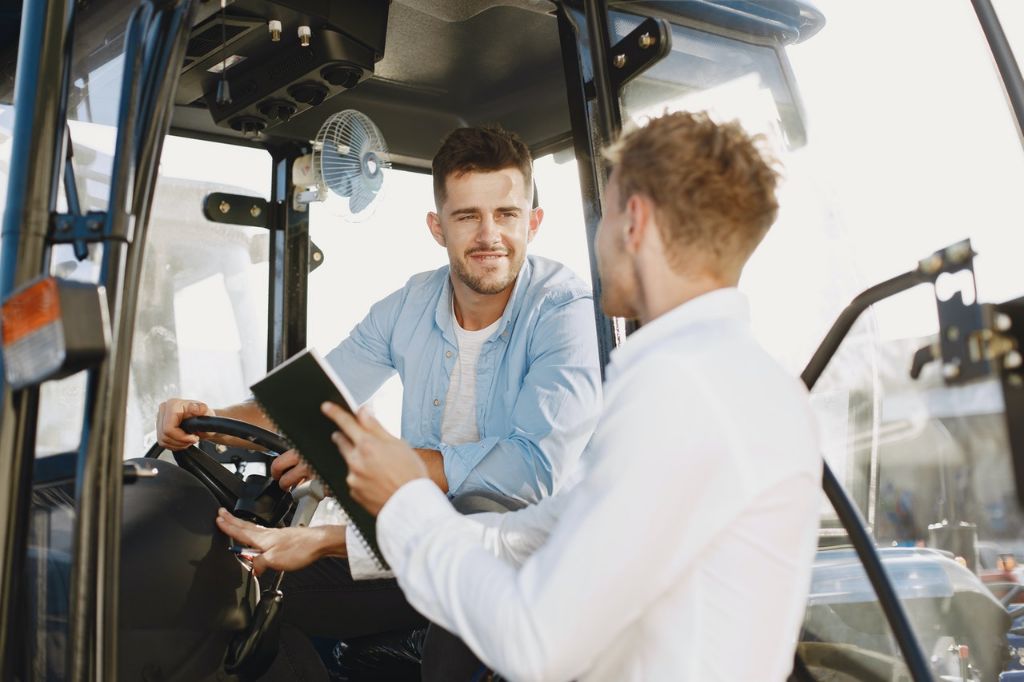
A forklift propane tank is a specially designed fuel storage cylinder used to power propane-fueled forklifts. These tanks are built to be durable and to safely contain propane gas under pressure while allowing for easy attachment and removal from the forklift. Propane forklifts are common in various industries due to their efficiency and the clean-burning nature of the fuel.
The date stamp on a forklift propane tank is a critical feature that indicates the tank’s manufacture date and the last requalification date. These stamps are crucial for several reasons:
- Safety: Propane is a flammable fuel, and the integrity of the tank that contains it is vital to prevent leaks, which can lead to fires or explosions. An outdated tank may not have the structural integrity to safely hold propane, especially if it has been subject to corrosion or damage.
- Compliance: Regulatory agencies require regular inspections and requalification of propane tanks to ensure they meet current safety standards. The date stamp helps inspectors and users know whether a tank is within its certification period or if it needs to be requalified or taken out of service.
- Operational Integrity: Using a tank that is beyond its requalification date can lead to operational failures, which may interrupt workflow and result in costly downtime or repairs.
- Liability: Failure to adhere to safety regulations can lead to severe legal and financial consequences for businesses.
The purpose of this is to inform forklift operators, facility managers, and safety inspectors about the importance of the propane tank date stamp. It aims to provide a comprehensive understanding of how to read and interpret these stamps, the requalification process, and best practices for maintaining propane tank safety and compliance. Through this knowledge, businesses can ensure the safe operation of their forklifts, stay in compliance with regulations, and maintain a safe work environment.
How to Read the Date Stamp
The date stamp on a forklift propane tank is a key indicator of the tank’s status and is essential for ensuring safety and compliance. Understanding how to locate and interpret this stamp is critical for anyone responsible for managing these fuel sources.
A. Location of the Date Stamp on Forklift Propane Tanks
The date stamp is typically found on the collar, handle, or foot ring of the propane tank—areas that are generally protected from wear and tear and can be easily accessed for inspection. It’s embossed or stamped into the metal, ensuring that it remains legible over the life of the tank.
B. Understanding the Coding System of the Date Stamp
The date stamp usually comprises a combination of letters and numbers that denote the month and year of manufacture, as well as the last requalification date. Here’s how to understand this coding system:
- Month and Year Format: The most common format includes two letters or numbers that represent the month and the last two digits of the year. For instance, “06 20” typically means the tank was manufactured or last qualified in June 2020.
- Special Markings and What They Mean: Additional letters or symbols can indicate specific information about the tank’s requalification. For example:
- A letter “E” followed by numbers can indicate the tank has passed an external inspection.
- A “PLUS” sign might indicate that the tank has undergone additional tests allowing for a longer service period.
- “S” or “Star” may signify a special type of inspection that could extend the tank’s service interval.
C. Examples of Date Stamps and Their Interpretation
Let’s look at a few examples of date stamps and break down their meanings:
- Example Stamp: “A 20”:
- Interpretation: If “A” corresponds to January (often manufacturers use A for January, B for February, and so on), this tank was manufactured or requalified in January of the year 2020.
- Example Stamp: “06 20 + 5Y”:
- Interpretation: The tank was manufactured or requalified in June 2020, and the “+ 5Y” indicates that the tank has a 5-year requalification interval.
- Example Stamp: “12 15 * E”:
- Interpretation: This tank was either manufactured or last requalified in December 2015, with a star symbol suggesting a special inspection was conducted, and the “E” indicating it passed an external inspection.
Understanding these stamps is crucial for maintaining a regular inspection and requalification schedule. It is advised that if there is any uncertainty in interpreting these stamps, consult with a certified professional who can ensure that the tanks are handled in accordance with the appropriate safety standards.
The Significance of Propane Tank Date Stamps
Propane tank date stamps serve as a vital checkpoint in the lifecycle management of forklift fuel resources. They are not merely markers of time but are pivotal in addressing safety concerns, adhering to legal mandates, and signaling the need for essential maintenance.
A. Safety Concerns Associated with Outdated Propane Tanks
Outdated propane tanks pose significant safety risks, primarily because the structural integrity of a tank diminishes over time due to factors such as:
- Metal Fatigue: Repeated filling and emptying can stress the tank’s structure.
- Corrosion: Both external and internal corrosion can compromise tank walls.
- Wear and Tear: Dents, scratches, and other physical damage from everyday use can affect the tank’s safety.
These issues can lead to dangerous propane leaks or catastrophic tank failures. A compromised tank could result in gas releases that may ignite if exposed to a spark or high heat. Such an event is not only dangerous for the immediate area around the forklift but can also pose a broader fire hazard to the facility in which it is housed.
B. Legal and Regulatory Requirements for Tank Inspections and Certifications
To mitigate the risks associated with propane storage, there are stringent legal and regulatory frameworks in place:
- Inspection Intervals: Regulatory bodies specify how often propane tanks must be inspected and requalified. These intervals ensure tanks are evaluated regularly for safety.
- Requalification Procedures: There are prescribed methods and tests that certified professionals must perform during requalification, including pressure tests, visual inspections, and thickness evaluations.
- Documentation: Every inspection and requalification must be documented, with the date stamp on the tank updated to reflect compliance.
Failure to follow these requirements can lead to legal penalties, including fines and operational shutdowns, as well as increased liability for accidents.
C. How Date Stamps Help in Identifying the Need for Requalification or Replacement
The date stamp is integral to the safe and legal operation of propane-powered equipment:
- Clear Timeline: The date stamp provides a clear and unambiguous timeline for when the tank was last certified as safe to use.
- Requalification Schedule: By knowing the tank’s age and last requalification date, facility managers can schedule inspections proactively before a tank potentially becomes unsafe.
- Replacement Decisions: If a tank is nearing the end of its usable life, the date stamp can be a deciding factor in determining whether to requalify or retire the tank.
In summary, the date stamp on a propane tank is a critical guidepost in the proactive management of forklift fuel resources. It ensures that the fuel powering businesses remains a source of efficiency and productivity, rather than a latent hazard.
Forklift Propane Tank Sizes
There are a variety of forklift propane tank sizes in existence, each with their own benefits and drawbacks. The most common size is the 33-pound tank, which is typically used on smaller forklifts; this capacity can power the vehicle for an average of 8 hours. These tanks are relatively easy to maneuver and can be refilled quickly. However, they do not hold a large amount of propane, which can be a problem if the forklift is used for extended periods of time.
The next size up is the 43-pound tank, which is more appropriate for larger forklifts. These tanks hold more propane but can be more difficult to maneuver. They also require a longer refill time. These tanks are typically used on the largest forklifts and can hold a significant amount of propane. However, they are very difficult to maneuver and can take a long time to refill because of their weight.
Forklift Propane Tank Certifications
Forklift propane tank date stamps are found on the collar of most propane tanks. They are used to track the last time the tank was certified. The date stamp is important because it lets you know when the tank needs to be recertified.
Its main purpose is to ensure that the tank is safe to use. The manufacture date of the tank is stamped on the collar, it needs to be retested when it reaches 12 years. After that, they need to be recertified. The date stamp lets you know when the tank was last certified, so you can make sure it is still safe to use.
If you have a propane tank that does not have a date stamp, you should not use it. This means that the tank has not been properly inspected and could be unsafe. If you have a propane tank that is old, you should get it recertified. You can do this by taking it to a certified propane dealer or to a qualified technician.
The Requalification Process for Propane Tanks
Requalification is a mandatory process that ensures the safety and integrity of propane tanks. It involves several inspections and tests that must be carried out by a certified professional.
A. What Happens During Requalification?
- Visual Inspections:
- The first step in the requalification process is a thorough visual inspection. The inspector will check for dents, rust, corrosion, and any other signs of wear and tear that could compromise the tank’s safety.
- They will also inspect valves, connectors, and the overall integrity of the tank to make sure there are no visible signs of damage or leaks.
- Pressure Testing:
- This involves filling the tank with water or another non-compressible fluid and subjecting it to higher-than-normal pressures to ensure that it can safely hold propane.
- The test will identify any leaks, weaknesses in the metal, or other failures that are not visible to the naked eye.
- Repair and Replacement of Components:
- If any issues are found during the visual inspection or pressure testing, parts or components may be repaired or replaced as necessary.
- Some components like valves and O-rings are often replaced as part of the requalification process, even if they show only minor wear.
B. Frequency of Requalification as Indicated by the Date Stamp
- The date stamp on a propane tank indicates when the last requalification was performed. Most tanks require requalification every 5, 7, or 12 years, depending on their design and the regulations that apply to their use.
- It’s important to note that different countries and regions may have different requirements for the frequency of requalification. Always check the local regulations to ensure compliance.
C. Documentation and Certification After Requalification
- Once a tank has passed the requalification, it must be documented. The qualifier will update the date stamp on the tank to show the latest inspection date.
- They will also provide documentation certifying that the tank has been requalified. This certificate should indicate the date of the requalification, the methods used, and the name and signature of the inspector.
- This documentation is crucial for proving compliance with safety regulations and must be kept on file and readily accessible.
The requalification process is a critical component of propane tank maintenance. It ensures that tanks remain safe for continued use and that businesses comply with legal and regulatory standards. Properly maintained and requalified tanks contribute significantly to the safety and efficiency of operations that rely on propane-fueled equipment.
Related Propane Tank Regulations
There are three (3) regulations:
- Department of Transportation – Requalification Guidance for Propane Cylinders
- Occupational Safety and Health Administration(OSHA) – 29 CFR 1910.110 – Storage and Handling of Liquefied Petroleum Gases
- National Fire Protection Association – NFPA 58 Liquefied Petroleum Gas Code 1998 Edition
Forklift Propane Tank Maintenance
Regular maintenance of forklift propane tanks is essential not just for compliance with regulations, but also for ensuring the safety and longevity of the equipment. Here are some maintenance tips for keeping forklift propane tanks in top condition.
A. Regular Inspections and What to Look For
- Daily Checks:
- Before use, visually check the tank for dents, rust, or any signs of damage.
- Inspect hoses and connections for wear, leaks, or damage.
- Weekly Assessments:
- Look for any signs of gas leaks, such as a hissing noise or the smell of propane.
- Ensure that tank mountings and fittings are secure.
- Monthly Evaluations:
- Check the condition of valves and O-rings, replacing them if they appear worn or damaged.
- Look for excessive rusting, particularly around the bottom of the tank where moisture can accumulate.
- Annual Inspections:
- Have a professional inspect the tank at least once a year for signs of wear that may not be obvious to untrained eyes.
B. Proper Handling and Storage to Extend Tank Life
- Handling:
- Always handle propane tanks with care to prevent dents and damage.
- Use proper lifting techniques and equipment when moving tanks.
- Storage:
- Store propane tanks upright in a well-ventilated area away from direct sunlight and extreme temperatures.
- Keep tanks away from areas where they could be knocked over or damaged.
- Store tanks in a location that is free from flammable materials and away from sources of ignition.
- Environment:
- Regularly clean the area around stored tanks to prevent the accumulation of combustible debris.
- Ensure that storage areas are free from excess moisture to prevent rusting.
C. When to Consult a Professional for Inspection or Replacement
- Following an Incident:
- If a tank has been involved in an accident or impact, have it inspected by a professional even if no damage is immediately evident.
- Signs of Wear:
- If during regular inspections you notice signs of serious wear or damage, such as deep rusting, dents, or persistent leaks, consult a professional.
- Performance Issues:
- If the forklift is underperforming or you notice inconsistencies in the performance that could be related to fuel supply, have the tank and system checked.
- End of Life:
- If a tank is nearing the end of its requalification period and it’s showing signs of age, consult a professional to discuss whether requalification or replacement is the best course of action.
By following these maintenance tips and consulting professionals as needed, you can ensure that forklift propane tanks remain safe, compliant, and functional throughout their service life. Proper care not only supports operational efficiency but also reinforces a culture of safety within the workplace.
Incidents Where You Can Derive Lessons From
Examining both the negative consequences of neglect and the positive results of diligence in monitoring and adhering to date stamp guidelines on forklift propane tanks can offer valuable insights for businesses and safety managers.
A. Incidents Resulting from Neglected Date Stamps
- Case Study: Industrial Accident Due to Overdue Requalification
- Overview: A manufacturing facility experienced a forklift malfunction resulting in a small fire. Upon investigation, it was discovered that the propane tank involved was several months past its requalification date.
- Consequences: The outdated tank had compromised integrity, leading to a propane leak. This incident resulted in costly property damage, operational downtime, and severe penalties for safety regulation violations.
- Lessons Learned: Regular inspection and adherence to requalification dates are critical in preventing such accidents. Following the incident, the facility implemented a strict policy for monitoring tank dates.
- Case Study: Warehouse Explosion Linked to Corroded Propane Tanks
- Overview: A warehouse storing expired propane tanks faced a catastrophic explosion. The cause was traced back to corrosion in tanks that had not been inspected or requalified on schedule.
- Consequences: Significant damage to the warehouse, serious injuries among staff, and a subsequent investigation led to the discovery of systemic neglect in maintaining tank safety standards.
- Lessons Learned: This tragic event highlighted the importance of regular tank inspections and timely requalification. New standards were set industry-wide for the storage and maintenance of propane tanks.
B. Positive Outcomes from Strict Adherence to Date Stamp Guidelines
- Case Study: Improved Safety Record Through Proactive Requalification Program
- Overview: A logistics company implemented a proactive tank requalification program that tracked and managed the requalification dates of their forklift propane tanks.
- Positive Outcomes: Over the years, the company maintained an exemplary safety record, with no incidents linked to propane tank failures. Their diligent tracking system became a model for industry best practices.
- Impact: The company not only avoided accidents but also enjoyed reduced insurance premiums due to their strict safety adherence, highlighting the financial benefits of safety compliance.
- Case Study: Retail Chain Recognized for Safety Leadership
- Overview: A national retail chain instituted a policy of checking date stamps during regular monthly safety audits, which included training staff to read and understand tank date stamps.
- Positive Outcomes: The chain was recognized with a national safety award and credited their thorough approach to tank management as a key factor in their success.
- Impact: Their commitment to safety and maintenance fostered a positive brand image, customer trust, and employee morale, demonstrating that investment in safety can yield broad business benefits.
These case studies serve as reminders that while the neglect of propane tank date stamps can lead to dire repercussions, conscientious observance can enhance safety, operational efficiency, and even provide positive recognition for the business.
Conclusion
In conclusion, the small step of regularly checking the date stamps on forklift propane tanks plays a significant role in maintaining workplace safety and efficiency. The stories of neglect serve as cautionary tales, reminding us that the consequences of overlooking such a simple detail can be severe, including accidents that can harm people and cause damage to property. On the flip side, the positive examples show that diligent adherence to safety protocols not only prevents accidents but can also elevate a company’s status and demonstrate its commitment to employee welfare and responsible operations.
It’s essential for businesses to instill a culture of safety that includes attention to the smallest details, such as the date stamps on propane tanks. By doing so, they safeguard against preventable mishaps, ensure compliance with regulations, and create a more secure environment for everyone involved. Regular inspections, proper storage, and timely requalification of propane tanks are straightforward practices that yield far-reaching benefits, from protecting lives to preserving the bottom line.

Mike is an experienced propane technician with over 15 years of professional experience in the field. He has dedicated his career to helping customers with their propane needs, from installation to maintenance and repair. Together with Jeremy, he co-founded this website to provide useful information and guidance to customers seeking reliable propane services.



